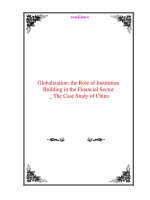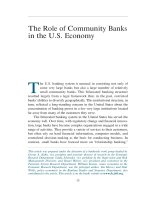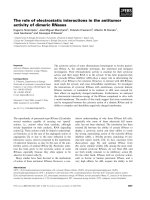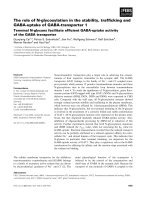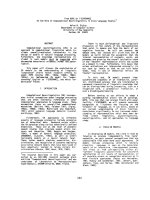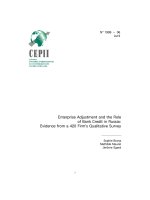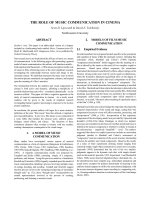The Role of Investment Funds in Romania pptx
Bạn đang xem bản rút gọn của tài liệu. Xem và tải ngay bản đầy đủ của tài liệu tại đây (587.85 KB, 15 trang )
The Romanian Economic Journal
Year XIV, no. 39 March 2011
45
The Role of Investment
Funds in Romania
Delia-Elena Diaconaşu
1
Alexandru Asăvoaei
2
The main aim of this article is to present the influence of investment funds on the
economic growth in Romania between 2007 and 2010. Unfortunately some of
the main findings of the paper are: insignificant share of investment funds in
GDP, low correlation between inflation rate and the net subscriptions of equity
funds, low correlation between benchmark interest rate and bond funds. Instead
we validated the direct relationship between monetary funds and the benchmark
interest rate. Also, the importance of national
investment funds
does reflect
in: the
share of net assets of financial investment companies in the market capitalization,
in the share of equity traded at the BSE in the UCITS portfolios, and in the
strong growth of net assets in recent years.
Key words: capital market, financial markets, monetary funds, financial
system, net assets, banking system, bonds, portfolio
assets, benchmark interest
rate
JEL Classification: G11, G14, G21, G24, D53, E43, E44
I. Introduction
Contemporary financial markets are now in constant transformation,
integration and interdependence. Their importance in the globalization
process is significant in a situation where financial conditions in one
1
Delia-Elena DIACONAŞU, PhD, University “Alexandru Ioan Cuza” of Iași,
2
Alexandru ASĂVOAEI, PhD, “University “Alexandru Ioan Cuza” of Iași,
The Romanian Economic Journal
Year XIV, no. 39 March 2011
46
region spread almost instantaneously over the others. In this context
the size of international financial markets has increased considerably,
along with the growing importance of institutional investors
(insurance companies, pension funds, mutual funds, investment trusts)
and the decline of individual investors. From this, mutual fund
segment is the most dynamic. Their importance derives from the fact
that are intermediaries that invest most in the financial market and the
fact that their dominant presence in general is making "any aspect of
investment performance measurement to the market makers and
analysts to be affected by their existence "( Rutterford & Davison,
2007, p. 356).
Investment funds have a very important role on global financial
market. First at micro economic level, from the investors' perspective,
they behave in terms of importance the following elements:
Investment funds are a significant source for businesses that need
capital (Stoica, 2008, p. 70), by transferring financial resources from
those who have surplus funds;
Investment funds give investors the opportunity to diversify the
portfolio on national and global financial markets (Reilly & Norton,
2006, p. 83), according to investment objectives, increasing the risks
dispersion and thus lower volatility;
Investment funds are offering a new line of products for investors (ex.
supermarkets and life-stage funds).
The set of benefits conferred by investment funds at the
microeconomic level will also affect the macroeconomic level, as
follows:
• A developed intermediaries sector positively influences the
stock markets by increasing market liquidity and emergence of
new effective financial instruments (Stoica, 2002, p. 105);
• Their role can be viewed through the development of other
sectors of the financial market, given that both insurance
The Romanian Economic Journal
Year XIV, no. 39 March 2011
47
companies, pension funds and banking groups find in
investment funds an attractive investment tool.
Protection of people's savings against inflation (MSCIBarra, 2008).
The shares and other variable income securities increase their value
once the development of the general price index, being among one of
the few profitable ways of investing in conditions of rising inflation.
The influence given by international and global funds in the balance of
payments, in order to increase the deficit while the capital outflows are
higher than the inflows and vice versa.
Investment funds also offer jobs to people, so a development of this
industry implicitly leads to a reduction in unemployment state.
Basically the investment funds, through specialization, financial
potency and access to certain databases, have the ability to harness and
interpret in a superior way the information. So, they are transforming
them into profitable investment process for both investors and issuers,
having a positive role on national, international and global financial
markets by stimulating the levels of investment.
II. The importance of Romanian investment funds
In Romania the section of investment funds stands in a incipient stage
of development, a small amount of money being used by the few
investors for such investments. This situation has been striving to
improve since 2009. This trend of improvement continued also in
2010, due to accelerated growth of the investment’s share in monetary
funds and bonds. In spite of this the obtained results have never
reached the global level of performance.
We can illustrate the little importance of this sector in Romania also by
analyzing the share of the total assets of investment funds in GDP
from 2007 – September 2010 period.
The Romanian Economic Journal
Year XIV, no. 39 March 2011
48
Analyzing the chart we can observe that the assets of investment
funds in the GDP from the analyzed time period, is very little – 3.1%;
1,4%; 2,2% and 3,13%.
Figure1
Source of data: www.insse.ro, www.aaf.ro
Analyzing the official reports of BNR on the financial stability from
the specified time period we can also see that the investment funds
industry has a reduced market share within Romania’s financial
institutions, surpassing only the pension funds of 2008. However the
situation reversed since 2009, the largest market share being assigned
to the credit institutions and nonbanking financial institutions, which
include more than 90% of the financial sector.
Comparing the level of this indicator with that registered in Europe,
we can confirm the weak representativeness of the Romanian
investment funds. The indicator is being situated far behind the rest of
The Romanian Economic Journal
Year XIV, no. 39 March 2011
49
the European countries excepting Bulgaria. So, it is obvious that the
effects of the global financial crisis on this sort of investments cannot
represent an excuse for those low values, taking in the account that
before 2008 and especially since 2009 the investment funds industry
became very important everywhere in the world. The resurgence of
this particular industry has been causing the same trend of growth for
the analyzed indicator. In Romania the investing funds industry began
to develop only with the crisis’ arriving. The exception was the year
2008 when there was a narrow tendency of decreasing of this segment
compared with the equivalent segments from Poland, Slovakia and
Hungary which registered the greatest contractions in eastern and
central Europe. The rising tendencies observed in Romania was due to
the specific advantages of the short term investments. But this rate of
growth is insufficient if we take a look to the growth rates of other
countries.
Also a GDP growth till 2008 including, has determined a growth of
the net assets, but the penalty component is missing in case of
economic recession. That makes impossible the transfers of Romanian
capital to a foreign expending market. That is because the funds’ assets
are almost entirely swallowed by the local market.
Anyway, beginning with 2009, GDP has started to fall (in the
background of financial crisis and due to the degradation of economic
condition) and the investment funds industry has started to grow
(precisely the monetary funds and the ones from the other category).
That is why, the ratio between GDP and net asset it remains
somewhat constant.
Taking into account that the banking institutions are very important to
Romanian economy, and as a result of the modifications suffered by
the law system in 2004 (witch stipulate their direct execution on the
capital market) the number of the banking groups that own
investment fund has raised significantly. So, some of the management
companies of the investment funds are owned by the banks. In
The Romanian Economic Journal
Year XIV, no. 39 March 2011
50
Romania there are twenty such companies. Eight of them ware created
by certain banking institutions, but fourteen of them are distributing
their funds through the banks. They chose this alternative because of
“the banks’ wide networks and highly qualified personal” (Moroşan,
2009, p. 260.). Another major advantage is the inexistence of the
distribution cost which reduces the administration fees. About the
market share of the management companies, in 2009, the first five of
them held about 90% of the net assets’ total value and they belong to
the banking institutions as following (Annual Reports of CNVM,
2009): Erste Asset Management – 43,08%, Reiffeisen Asset
Management – 30,24%, BRD Asset Management – 8,49%, BT Asset
Management – 4,86%, OTP Asset Management – 3,28%. This
situation is similar with the ones existing a year before and after. This
is due to the fact that these companies charge smaller fees than others.
Another factor that determined this situation is the confidence of the
people in the investments managed by the banks, given that the
mutual funds’ market was affected by major crisis. The clearing and
settlements agents accredited by CNVM are also the banks.
The competition existing between the UCITs’ net assets and the
amounts of money in bank deposits demonstrate the relevance of the
investment funds’ local market. During the period 2007 – 2010, we
can observe that the UCITs’ assets reached the following values: 6,6%,
2,5%, 3,5% and 3,8%. These values are determined first of all by the
increasing amounts of money attracted by the credit institution in the
latest two years, especially of those in foreign currency, and second by
the decreasing of the investment funds’ assets in 2008, followed by a
rapid growth. So, considering that the share of the amounts of money
invested in UCITs is very small compared to the savings invested in
credit institutions – though it is increasing since 2009 – we can’t talk
about a shift of the investments from the bank deposits to the funds’
market, which in Romania is based on the banking system. So, in spite
of the fact that in the last two years the growth rates of investments
funds’ industry is much higher than that of saving rates by the
The Romanian Economic Journal
Year XIV, no. 39 March 2011
51
instrumentality of credit institutions, it is not enough to match the
growth rates of investments funds with other European countries.
The direct relation between the inflation rate and equity funds, that
means the investment funds’ function of peoples’ savings protection
against inflation, at a national level cannot be applied. That is because
the level of net underwritings is too low, and every year is inversely
correlated with the inflation rate. Not even the weak correlation
between the interest rate and the bonds’ funds is surprisingly, given
that the beginning of funds industry phase affects these. An indirect
relation takes place only since 2009 when the decreasing of the
benchmark interest rate – from 10,25% to 8% in 2009 and to 6,25 in
2010 – takes place at the same time with the growth of the
underwritings of bonds funds with about 140% in 2009 and about
30% in 2010. This trend continues to this day, given that BNR has
maintained constant the benchmark interest rate (6,25% until
December 2011). This has determined the maintaining of a law
interest rate offered by the banks. This fact, put in touch, on one hand
with the higher yield of the bonds funds (of maximum 14,5% in 2009
and 11,79% in 2010 according to Aviva Investors Romania, 2010) and
on the other hand with the investors’ increased risk aversion (who
redirected their investments towards bonds funds because of the stock
market crash) had led to the development of this fixed income
instruments.
Theoretically, there would be a direct relation between the interest rate
and the investments in monetary instruments. In that an increase in
benchmark interest rate charged by banks would lead also to an
increasing in the efficiency of monetary funds, given that the
portfolios are mainly consisting of short and medium terms bank
deposits and certificates of deposit. So, the monetary funds are a good
saving alternative in preference to bank deposits, because they offer a
higher return together with many other advantages.
The Romanian Economic Journal
Year XIV, no. 39 March 2011
52
Analyzing the chart situated below, we can observe the direct
correlation between the benchmark interest rate and the growth rate
of the monetary funds’ net underwritings. Until 2007 the monetary
funds were never attractive for the investors. In that period they had
lower efficiency compared to the competition who offered higher
interest rates (that includes the current accounts). For that reason it is
unlikely for the investors to prefer them.
The situation with regard to monetary funds is reversed since 2008,
when they have grown more than six times net subscriptions, and have
registered an increase of 164% of net assets. This trend occurred
against the backdrop of increasing the benchmark interest rate to
10.25% in that year, because they offer much higher yields than bank
deposits (since the portfolios have integrated bonds and government
securities) and because of the uncertainties that dominated the market.
The increasing trend of subscriptions is conserved in the next two
years, but to a lesser extent compared with the previous year.
Figure 2
Source of data: www.bnro.ro, www.aaf.ro
The Romanian Economic Journal
Year XIV, no. 39 March 2011
53
Although interest rates fell to 6,25%, the growth trend was
maintained. That is because the yields are higher than those offered by
bank deposits, since fund managers can negotiate with the banks
higher interest rates than those offered to the public. This negotiation
is possible because the funds accumulate large amounts. The growth
also maintained is due to the anti-crisis measures taken by the
Government where is also found relief from capital gains tax
applicable to such types of funds.
Also, the largest share market of monetary funds belongs to the banks,
because of the strategy adopted for the sale of these products and
because of the fact that most investors are coming from existing
customers of the bank (the monetary fund is then a complementary to
deposit). So, the trend of growth was maintained until the present, but
at a slower rate. That is due to the very high decrease of benchmark
interest rate to 6,25% and hence the lower yield monetary funds, in
the conditions under which they are seen as short-term and very short-
term investments.
However, not only the dependence on the rate of inflation and on the
benchmark interest rate have contributed to the growth of investment
fund’s net assets and have influenced investor’s behavior. It arose as a
result of capital market development and rebuilding population’s
confidence in the investment funds. So, particularly important is the
role that investment funds have in the local stock market
development, both within the market capitalization and in terms of
investment policy adopted by fund managers.
The chart below shows the market share evolution of the five SIF in
the national stock market. The total market capitalization weights have
relatively constant between 2005-2009 (9.04% 10.56% 13.38%
12.72%, 9.33% and 7,42% respectively), but the share in total trading
volume is particularly high, ranging between 30% and 85% in the
analyzed period.
The Romanian Economic Journal
Year XIV, no. 39 March 2011
54
Figure 3
Source of data: www.bvb.ro, www.aaf.ro
Fairly large share of the SIFs and the increase of their assets by the
year 2007 was mainly due to: the lack of attractive investment
alternatives, the discount to market value of the asset components,
price corrections that are delayed (especially when they have a
increasing trend), the fact that are the most liquid shares and not least
due to increased holdings of the threshold from 0.1% to 1%.
Especially in 2006 and 2007 financial investment company’s
performance generated upward trend of Romanian stock exchange on
the background of increasing volume of transactions.
In 2008, although share capitalization of the SIFs in total capitalization
remained relatively constant, this is not due to their performance, but
to the stock market decline, which led to lower total market
capitalization by almost 47%, lower number of transactions by 13 %
and hence BET-FI decreased by 84%. These reductions have led to
lower prices of the shares and reduction in financial investment
company portfolio performance.
The Romanian Economic Journal
Year XIV, no. 39 March 2011
55
The stock exchange recovery trend was retaken in 2009, but growth
accelerated stock market capitalization (which is almost the amount
from 2007) exceeded significantly the increase of financial investment
company net assets (28.3%). That’s due to high volatility prices
recorded during the year. Almost the same thing happened in 2010,
when SIF’s net asset fell because of the portfolio component (it had
less liquid shares).
Figure 4
Source of data: www.aaf.ro
Therefore, the most important sector of national stock market is
represented by SIF (over 50% of the market). They play an important
role in the stock exchange. Next we will analyze the role of mutual
funds in the capital market by reporting the traded equity of BVB in
UCITS portfolio in Romania.
From the graph we can see that fund managers have adjusted their
investment policies depending on the evolution of portfolio assets.
Thus, while the market value of shares traded in the composition of
portfolios is high (in 2006 and 2007), providing high yields, then the
high share of investments in quoted shares is high. Capital market
turbulence in Romania in 2008 which caused the reducing of equity
The Romanian Economic Journal
Year XIV, no. 39 March 2011
56
price and consequently the yield offered by them, has reduced the
share of traded equity on the BSE in the existing portfolio of assets.
Stock market development since 2009 once again led to a slight
increase of listed equity, a trend that manifests itself today, due to the
increasing of the indices. Therefore, managers change their investment
policy based on stock market developments.
Conclusions
In conclusion, while subscriptions in investment funds in Romania is
still low compared to all European countries, their role in financing
the real economy is not negligible - although it is found behind the
banking system – observing an increase since 2009, and continuing
with a lower rate of growth in 2010. Consequently, unlike other states
in which the reduction of this industry has led to the decline of
financial market, in Romania the risk induced by this sector on the
financial system as a whole is still relatively low. That is because of the
low share of owned assets by them in total assets.
Regarding the interrelationship between investment funds and
investment growth, we checked the validity of assumptions made
about the role of investment funds. Therefore, are not surprising the
conclusions that we have reached: insignificant share of investment
funds in GDP, low correlation between inflation rate and the net
subscriptions of fund shares, low correlation between benchmark
interest rate and bond funds. Instead we checked the direct
relationship between money funds and the benchmark interest rate.
The correlation between investment funds and the macroeconomic
indicators is weak for the Romanian economy, on the one hand due to
the reduced share of the funds in the total economy, and on the other
hand because of developments atypical features a maturing market.
The importance of national investment funds does reflect in both the
share of net assets of financial investment company in the market
capitalization and in the share of equity traded at the BSE from
The Romanian Economic Journal
Year XIV, no. 39 March 2011
57
UCITS portfolios, on the one hand, and in the strong growth of net
assets in recent years compared with increasing amounts placed in
bank deposits.
The increasing trend of investment funds sector has started in terms
of the global financial crisis. Is expecting that, after the stock market
recurrence, after the economic recovery and because of the impact of
implementation the European directives, their role on the Romanian
financial market to grow considerably. This will eliminate major
differences now compared with other European countries. In this
regard the adoptions of certain measures are required by the
competent authorities and by the investment management companies.
These include: developing alternative distribution channels (like the
Internet), attracting and launch of new financial tools, improving
services related to promoting, a stable fiscal framework.
Acknowledgement
This work was supported by the the European Social Fund in
Romania, under the responsibility of the Managing Authority for the
Sectoral Operational Programme for Human Resources Development
2007-2013 [grant POSDRU/CPP 107/DMI 1.5/S/78342].
References
Aviva Investors Romania (2010), Cat de atractive sunt fondurile de
obligatiuni?, />sunt-fondurile-de-obligatiuni/, Accessed on June 2010.
BNR (2010), Reports on financial stability,
Accessed in
December 2010.
The Romanian Economic Journal
Year XIV, no. 39 March 2011
58
BSE (2010), Market capitalization,
Accessed in
December 2010.
CNVM (2009), Annual Report,
Accessed on December
2010.
INSSE (2010), Monthly Statically Bulletin,
/>=0a02458c30d550d7fda54cdc43fab67a95089cf660cf.e38QbxeSahyTbi
0Se0, Accessed in December 2010.
Moroşan, G. (2009), “Creditele şi plasamentele bancare în titluri de
valori mobiliare”, Ed. Didactică şi Pedagogică, Bucureşti.
MSCIBarra (2008), “Hedging inflation with equities”,
/>lation_with_Equities.pdf, Accessed on April 2010.
Reilly, F. K. and Norton, A. E. (2006), E. A., “Investments”, Seventh
Edition, Ed. Thomson SouthWestern, Canada.
Romanian Association of Asset Managers (2010), Evolution of net
subscriptions and net assets – UCITS,
/>&catid=33&Itemid=35, Accessed on December 2010
Romanian Association of Asset Managers (2010), Evolution of net
assets, NAV and closing prices – SIF,
/>&catid=33&Itemid=35, Accessed on December 2010
Rutterford, J. and Davison, M. (2007), “An introduction to stock
exchange investment”, 3
rd
Eddition, Ed. Palgrave Macmillan, New
York.
Stoica, O. (2008), “Curs-Reglementări şi instituţii ale pieţei de capital”,
Univ. Al. I. Cuza, Iaşi;
The Romanian Economic Journal
Year XIV, no. 39 March 2011
59
Stoica, O. (2002), “Mecanisme şi instituţii ale pieţei de capital. Pieţe de
capital emergente”, Ed. Economică, Bucureşti.

